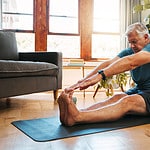Introduction
Knee pain can be a huge struggle. It can seriously affect how you do everyday tasks and can cause dread and anxiety. Even though it’s not fatal, the emotional toll of persistent knee pain can be overwhelming. Fortunately, there are ways to reduce the risk of knee pain and help with its recovery.
In this article, we’ll look at techniques to help you manage your knee pain. We’ll look at:
- what supports the knee
- lifestyle changes to reduce pain
- strengthening exercises
- therapeutic options like physical therapy or medical intervention.
We hope this guide helps you to live free from knee pain. Whether you have a sports injury or just general wear-and-tear, you can take proactive steps to better health.
Causes of Knee Pain
Knee pain may have many causes. It is vital to find out what is causing it, so you can treat it. Potential sources of knee pain are:
- Injuries from sports
- Arthritis
- Overuse
- Bad posture
You must take the time to figure out why your knee hurts, so you can get the right treatment.
Common Causes of Knee Pain
Knee pain is a common issue for many people. Causes can vary but some of the more frequent ones are:
- Arthritis: This condition results in swelling, stiffness and inflammation of the joint. Symptoms are often worse in cold or damp weather. Osteoarthritis is the most common form and usually appears as people age.
- Tendinitis: Overuse of tendons in the knee can lead to this. It can be caused by athletes who frequently jump or twist their legs. It could also be due to strain on the joint from an imbalance in strength or movement in the muscles.
- Bursitis: Fluid-filled sacs between bones, muscles and tendons can become inflamed. This can be caused by excess strain, repetitive motions, an acute injury, obesity, gout, diabetes, rheumatoid arthritis or hip disease.
- Muscle strain: Running, jumping, skiing etc. can put too much stress on certain parts of the muscle group around the knee joint. This can result in imbalances in strength which can cause pain and discomfort.
- Meniscus tears: Cartilage between the thighbone and shinbone can tear due to trauma from sports activities or accidents. It can also occur with age as the cartilage weakens and can’t withstand pressure. This can lead to sharp pains and difficulty with everyday tasks. It can also cause instability in the joints, with an inability to move certain ranges due to ‘locking’. This can be very severe if it affects both legs at the same time.
When to See a Doctor
Knee pain can result from many things, like illnesses, injuries, and regular wear. Depending on its severity, it’s best to talk to a doctor.
If there is swelling or inflammation, redness or discoloration, or pain when wearing shoes, it’s time to see a doctor. Swelling and joint sounds can also be signs.
Other signs include:
- Sudden weakness in the leg
- Cannot completely bear weight
- Cannot flex without hurting
- Unstable when walking down stairs or inclines
- Knee stiffens after sitting or lying down
- Sharp pains when stretching or doing physical activity
- Tenderness around joint areas and creaking sounds when you move.
If any of these are present, plus extreme soreness or stiffness—make an appointment with a doctor. It’s important to check for underlying conditions that could affect health if untreated.
Knee-Friendly Techniques
Do you have knee pain? Or just stiffness? Taking action is key. For relief and to stop it coming back, rest and recovery are essential. This article will tell you all about knee-friendly techniques that can help you rest and recover with no pain.
Physical Therapy
Physical therapy is a popular choice for those looking to recover from a knee injury or reduce chronic pain. A physical therapist will analyze the source of knee pain and work to strengthen and increase mobility in the area.
Knee exercises may include:
- Range-of-motion exercises to keep flexibility.
- Stretching to increase flexibility and reduce joint stiffness.
- Strengthening exercises like squats, lunges, leg lifts, and calf raises to improve stability.
Balance training can also help with prevention, such as tandem walking, single-leg stands, step box training, and other balance equipment.
Additionally, other therapies such as dry needling or therapeutic ultrasound may be prescribed if necessary. Lastly, a physical therapist is qualified to provide instruction on how to use any aid, such as splints or braces, correctly outside of the therapy session.
Strengthening Exercises
Strengthening exercises are essential for knee-friendly exercise and rehabilitation. They focus on building and stabilizing muscles in the lower body, as well as improving joint strength and stability. With regular strengthening exercise, you can reduce the risk of re-injuring your knees or developing new knee injuries.
The exercises should target the quadriceps and hamstrings. Examples include: leg lifts, wall squats, step-ups, calf raises and clamshells.
When doing these exercises, use good form. Start with lighter weights that don’t cause strain or discomfort to your knees. Gradually increase the weight as you gain control and strength.
In addition to resistance training, activities like biking and swimming help strengthen weakened joints. They cause minimal strain on other body parts.
It’s important to practice good alignment while exercising. This helps reduce the stress on joints and muscles in areas like the hips or lower back. This is especially true for people who suffer from chronic joint pains such as arthritis.
Foam Rolling
Foam Rolling is a way to do self-myofascial release (SMR). It’s the same as massaging muscles. You can use foam rollers, lacrosse balls, massage tools, or your hands. The idea is to put pressure on certain spots. This helps break apart knots or tightness in the muscles.
Foam Rolling is very helpful for knee problems. It can reduce tension and make it easier to move. It also stimulates the fascia–that’s the tissue that covers muscles. That can help improve range of motion and reduce tightness. Foam Rolling also helps with recovery after workouts. It increases lymphatic flow and circulation in the area.
To get started with Foam Rolling, sit on a flat surface like a mat or carpet. Use a supportive roller–one option is a long one made for painful areas like knees. Go slowly, focusing on tender spots. Hold each point for 15-30 seconds before moving to other parts of your leg. Work from upper thigh to lower calf/ankle.
Stretching
Stretching is a must to keep your knees healthy. Dynamic stretches should be done before activity. Static stretching should be done after activities to relax muscles.
Quads, hamstrings, hip flexors, IT band should be stretched regularly. For quads try a standing thigh stretch with hand on a wall for support. Hug thigh to chest and push pelvis forward for deeper stretch. Stretch both legs for 20-30 seconds each.
Hamstrings can be stretched sitting down using a towel looped around the ball of your foot. Keep spine straight. Gently pull on the towel and push through the heel for 15-20 seconds each side.
IT band stretches involve crossing one leg over the opposite leg’s knee. Slowly lower yourself towards one side until you feel a gentle pull along your IT Band. Hold for 10-15 seconds before switching sides.
Hip flexors can be stretched in an extended lunge position. Lean hands against a sturdy wall to minimize stress on knee joints. Engage core throughout all stages of motion to avoid straining muscles. Hold for 10-15 seconds before releasing.
Ice and Heat Therapy
Ice and heat therapy are both good for reducing knee pain and speeding up healing. Knowing when to use each is important.
- Ice is best for reducing swelling, pain and preventing further damage. Apply an ice pack for 15 minutes every hour until the pain lessens. Never put the ice directly on the skin, as this can cause more harm.
- Heat might be more helpful than cold therapy for chronic injuries or flare-ups. Heat relaxes tight muscles and stiff joints that have been aggravated. It increases blood flow which helps heal soft tissues. Heat doesn’t provide any pain relief but it increases range of motion. Put heat on before exercise or physical activity, or before doing daily activities. For the best results, use heat therapy for 13-20 minutes once a day, and then do light stretching.
Conclusion
When it comes to knee pain and injury, it is essential to remember that every person is unique. What works for one person may not be the same as another’s. If pain persists even after following guidelines, contact a medical professional quickly.
Listen to your body. When you need rest, rest and be aware of any warning signs of knee injury or chronic pain, such as bursitis or tendinopathy. Taking the correct steps and taking care of your knees will help you to move forward pain free.
Frequently Asked Questions
Q: What are some techniques to recover pain-free from knee injuries?
A: One way to recover pain-free from knee injuries is to use rest and gentle exercises to help build strength and flexibility. Examples of gentle exercises include gentle stretches, low-impact aerobic exercises such as swimming and stationary biking, and strength-training exercises that focus on the muscles around the knee.
Q: What are the benefits of rest and recovery for knee pain?
A: Rest and recovery are important for managing knee pain, as they allow the tendons and ligaments in the knee to heal and prevent further injury. Rest and recovery can also help reduce swelling and inflammation, improve range of motion, and reduce pain.
Q: What are some knee-friendly activities to avoid?
A: It is important to avoid activities that place too much stress on the knees, such as running, jumping, and high-impact aerobics. It is also important to avoid activities that involve sudden, jerky movements, as these can cause further injury to the knee.





